Understanding Freshwater Pearls: A Comprehensive Exploration
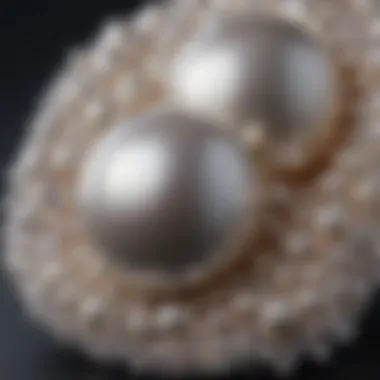
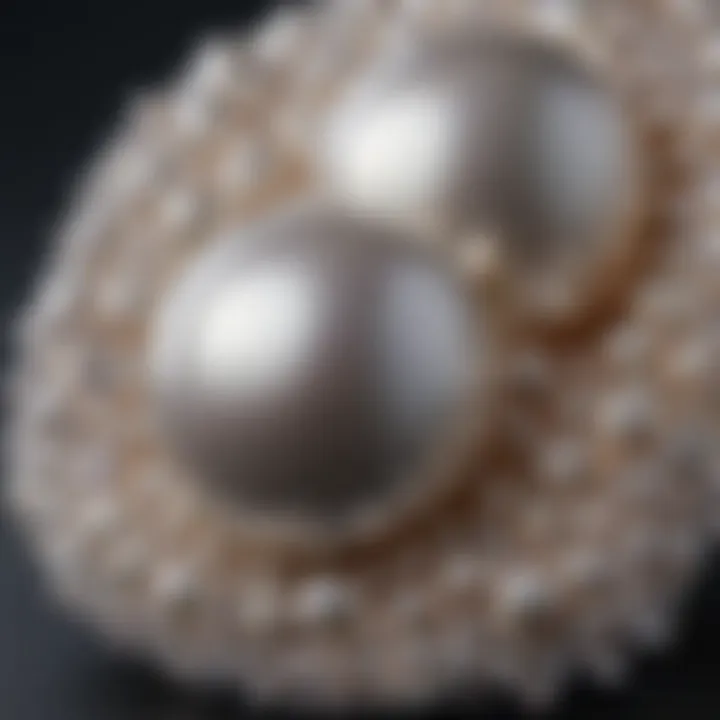
Intro
Freshwater pearls hold a unique place in the gemstone world. They are distinguished not only by their formation but also by their aesthetic appeal and cultural significance. Understanding these gems requires an exploration of their origins, types, and the ways they capture human interest across different cultures. Each pearl tells a story, shaped by both natural processes and human intervention.
Gemstone Overview
Definition and Characteristics
Freshwater pearls are produced by mollusks living in rivers, lakes, and ponds. Unlike their saltwater counterparts, they often feature a variety of colors and shapes. Their unique shimmering luster is the result of nacre, a substance secreted by the mollusk to protect itself from irritants. The thickness of nacre influences the pearl's quality—thicker layers tend to yield more lustrous pearls.
The main characteristics of freshwater pearls include:
- Shape: They can be round, oval, baroque, or other shapes.
- Color: Varying from white and pink to lavender, the color often reflects the mollusk species and water conditions.
- Size: Generally, freshwater pearls are smaller than saltwater pearls, ranging from 2mm to 15mm.
Classification of Gemstones
Gemstones are classified based on various criteria, including their physical properties, chemical makeup, and origins. Freshwater pearls specifically fall into the category of organic gemstones, which also includes amber and coral. Organic gemstones are derived from living organisms and have unique formation processes largely influenced by environmental factors.
Historical Significance
Ancient Uses and Cultural Importance
From the ancient worlds to modern times, pearls have been regarded as symbols of wealth and purity. In many cultures, they were used in jewelry reserved for royalty or spiritual leaders. For example, in ancient China, freshwater pearls were often associated with the moon and its qualities of serenity and wisdom. Historically, they were also seen as tools for medicinal purposes, believed to hold healing properties.
Myths and Legends Surrounding Gemstones
Various myths surround pearls, adding to their allure. In some cultures, they were thought to bring good fortune and protection against evil. In others, their formation was shrouded in mystery. Some legends claimed that the tears of angels turned into pearls, bestowing a source of divine beauty.
"The pearl is the most precious gem that nature can give to us, a symbol of a pure heart and a peaceful mind."
Understanding these narratives is essential for appreciating not just the beauty of freshwater pearls but also their cultural relevance that is threaded throughout history.
This exploration into freshwater pearls provides foundational knowledge. The subsequent sections will delve deeper into their cultivation, market trends, and care requirements, offering practical guidance tailored for enthusiasts and professionals alike.
Intro to Freshwater Pearls
Freshwater pearls have captivated jewel enthusiasts and collectors alike for centuries. Understanding these unique gems is crucial for anyone interested in the realm of fine jewelry. Freshwater pearls originate from freshwater mollusks, with their formation process being quite different from that of saltwater pearls. This difference leads to a variety of shapes, sizes, and colors, making them distinct and valuable in their own right.
The growing popularity of freshwater pearls can be attributed to several factors. They are often more affordable than their saltwater counterparts, allowing a wider audience access to their beauty. Additionally, the diversity in their appearance offers something for everyone. Jewelry designers often appreciate the distinct characteristics of freshwater pearls, enabling them to create innovative and unique pieces.
By diving into the world of freshwater pearls, individuals gain insights into their classification, cultivation, care, and cultural significance. This knowledge not only enriches one’s appreciation of the gemstones but also informs better purchasing decisions.
Definition and Basic Characteristics
Freshwater pearls are created inside freshwater mollusks, primarily the hyriid family. Unlike saltwater pearls, which form within oysters, freshwater pearls grow inside mussels, resulting in a different texture and appearance. These pearls are characterized by their unique shapes, which can range from perfectly round to quirky baroque forms. The variability in size and color adds to their appeal, showcasing hues that span white, pink, lavender, and even deeper shades.
Moreover, the luster of freshwater pearls tends to be slightly softer than that of saltwater pearls, yet they can exhibit a beautiful glow depending on the pearl's surface quality. The surface quality varies among pearls, with some displaying blemishes or natural markings. Collectors and jewelry lovers value freshwater pearls not just for their beauty but also for their individuality.
Historical Significance
The history of freshwater pearls dates back centuries. They have been used in adornments for thousands of years, particularly in regions near freshwater lakes and rivers. Unlike saltwater pearls, which were once associated primarily with royalty due to their rareness, freshwater pearls became widely accessible as pearl farming techniques developed in the 20th century.
In many cultures, freshwater pearls were considered symbols of purity and wealth. They were often used in ceremonial jewelry and bridal adornments, reflecting social status and cultural values. Today, freshwater pearls continue to hold a place of significance in various traditions, emphasizing their lasting impact within the jewelry landscape.
Formation of Freshwater Pearls
The formation of freshwater pearls is a critical aspect of understanding these unique gemstones. It involves both biological and environmental elements that are essential to creating pearls valued in jewelry and culture. The process, though natural, has nuances that impact the quality and characteristics of the final product. By exploring this topic, readers gain insight into not only how pearls form, but also how to appreciate their individuality and worth in the market.
Biological Process of Formation
The biological process of pearl formation begins when an irritant, such as a grain of sand or a parasite, enters the soft tissue of a freshwater mussel. The mussel reacts to this irritant by secreting layers of nacre, a substance composed primarily of aragonite and conchiolin. This secretion process can take years, and during this time, the layers accumulate around the irritant, eventually forming a pearl.
In contrast to their saltwater counterparts, freshwater mussels can produce multiple pearls simultaneously within the same animal. This results in a diverse range of shapes and sizes, as each pearl develops independently. The growth rate can depend on several factors, including water temperature, the health of the mussel, and the quality of the environment in which it resides.
Nacre and Its Role
Nacre, also known as mother-of-pearl, is pivotal in the pearl formation process. It is the substance that gives pearls their characteristic luster and shine. Nacre layers are composed of microscopic crystals that reflect light in a specific way, creating a range of colors and finishes. The thickness of the nacre is significant: thicker layers tend to create more durable and lustrous pearls while thinner layers may result in pearls that are less desirable.
The chemical composition of the nacre also influences the hue and overall appearance of the pearl. Freshwater pearls can display a variety of colors, from white to pastel shades, to deep hues depending on the type of mussel and the environment. It is crucial for collectors and jewelry designers to understand the role of nacre in the formation process, as it directly correlates with the quality and value of the pearls.
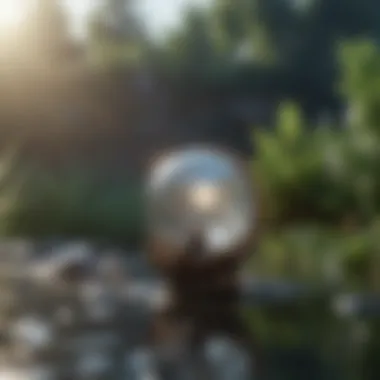

Nacre is not just a protective layer, but the core of a pearl's beauty and quality.
In summary, the formation of freshwater pearls combines biological processes with environmental factors, all centered around the crucial role of nacre. Understanding these elements offers deeper appreciation for the pearls themselves and informs better purchasing decisions.
Types of Freshwater Pearls
The classification of freshwater pearls is fundamental to understanding their diversity and significance in the gemstone market. Recognizing the various types of freshwater pearls allows enthusiasts and collectors to appreciate their unique characteristics and the conditions that affect their formation. The distinctions between these types highlight the distinct aesthetic and value considerations that come into play when purchasing or evaluating pearls. This section delves into the primary types of freshwater pearls: round, baroque, and Keshi, providing insights into their unique features and the factors influencing their desirability.
Round Freshwater Pearls
Round freshwater pearls are often considered the standard in the world of pearls. Their symmetrical shape is associated with quality and is sought after by buyers for various jewelry applications. The round shape results from the unique biological processes that occur in mollusks during pearl formation.
Typically, these pearls exhibit a smooth surface with minimal blemishes, contributing to their luster. The size of round freshwater pearls can range from small to large. Larger varieties tend to command higher prices due to their rarity. These pearls can be found in a spectrum of colors, including pastel shades like pink and lavender, as well as classic white.
Buyers often evaluate round freshwater pearls based on criteria such as surface quality, shape, and luster. To achieve a perfect round pearl, significant care is taken during the cultivation process, making them valuable additions to pearl collections.
Baroque Freshwater Pearls
In contrast, baroque freshwater pearls possess an irregular shape that distinguishes them from their round counterparts. This uniqueness can create striking and one-of-a-kind pieces in jewelry design. The asymmetry of baroque pearls allows for creative freedom and has made them popular among contemporary jewelry designers.
Baroque pearls exhibit a wide variety of colors, shapes, and sizes, which appeal to those seeking individuality in their jewelry. The surface characteristics of baroque pearls can range from heavily textured to smooth, offering further variety.
Due to their unconventional shapes, baroque freshwater pearls are often more affordable than round pearls, making them accessible for various consumers. They are increasingly used in modern fashion jewelry, as their imperfect beauty embraces the idea of uniqueness in craftsmanship.
Keshi and Other Variants
Keshi pearls are a fascinating category that deserves attention. Unlike other types, Keshi pearls form without a nucleus during the mollusk's reproductive process, resulting in purely nacreous formations. This leads to their distinctive, irregular shapes. Keshi pearls typically possess high luster and a soft, glowing appearance that attracts collectors.
These pearls are often smaller than round or baroque pearls. However, their rarity can elevate their status among pearl enthusiasts. Keshi pearls can come in various colors, enhancing their allure even further.
Other variants include unique shapes and sizes, such as coin-shaped or teardrop pearls. Each variant comes with its own characteristics, offering distinct options for buyers in the market. Collectors appreciate these unique forms for their individuality and artistry.
In summary, understanding the types of freshwater pearls — round, baroque, and Keshi — is essential for making informed purchasing decisions. Each type presents its unique aesthetics and value, catering to the preferences of gemstone enthusiasts, collectors, and jewelry designers alike.
Cultivation of Freshwater Pearls
The cultivation of freshwater pearls plays a vital role in the aquaculture industry and has garnered considerable attention due to its environmental, economic, and cultural implications. As freshwater pearls occupy a unique niche in the gemstone market, understanding the cultivation process can greatly enhance one's appreciation of these natural gems. This section outlines various farming techniques and considers the environmental impacts associated with pearl cultivation.
Pearl Farming Techniques
The methods employed in pearl farming directly influence the quality and characteristics of the pearls produced.
- Nucleation Process:
- Harvesting:
- Water Quality Management:
- Sustainable Practices:
- This involves inserting a small bead or piece of mantle tissue into a freshwater mussel, which triggers the formation of a pearl.
- The choice of nucleation technique can impact the size and shape of the resulting pearl.
- Typically occurs 2 to 5 years post-nucleation. Farmers evaluate each mussel for pearl quality. The mussels are then opened, and pearls are extracted carefully to avoid damage.
- Maintaining optimal water quality is crucial for healthy mussel growth. Factors such as pH levels, turbidity, and nutrient levels are closely monitored.
- Regular testing ensures that the mussels flourish in an environment conducive to pearl formation.
- Many pearl farms are adopting eco-friendly practices to minimize ecological footprints. This includes optimizing resource use and ensuring biodiversity is preserved in farming areas.
By adhering to these farming techniques, pearl farmers can create high-quality freshwater pearls while contributing to sustainable aquaculture.
Environmental Impact on Cultivation
The environmental impact of freshwater pearl cultivation is significant and multifaceted. Sustainable practices can mitigate damage to local ecosystems and ensure the long-term viability of pearl farming.
- Ecosystem Disruption:
- Invasive Species:
- Resource Utilization:
- Research and Mitigation:
- Traditional pearl farming can disrupt local aquatic ecosystems. Overcrowding and improper waste management can lead to nutrient depletion and harmful algal blooms.
- Some pearl farms inadvertently introduce invasive species, which can outcompete local flora and fauna, harming biodiversity.
- Water resources must be managed carefully to avoid excessive consumption, which can lead to a decline in local water quality and availability.
- Ongoing research aims to develop strategies to minimize negative impacts. Educating farmers on sustainable methods is crucial for fostering environmental stewardship in the industry.
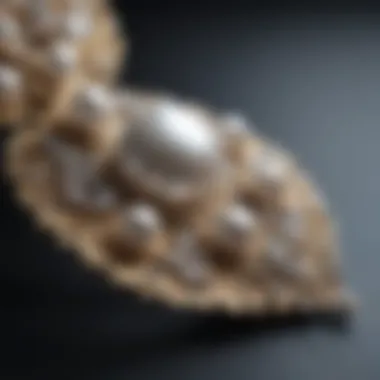
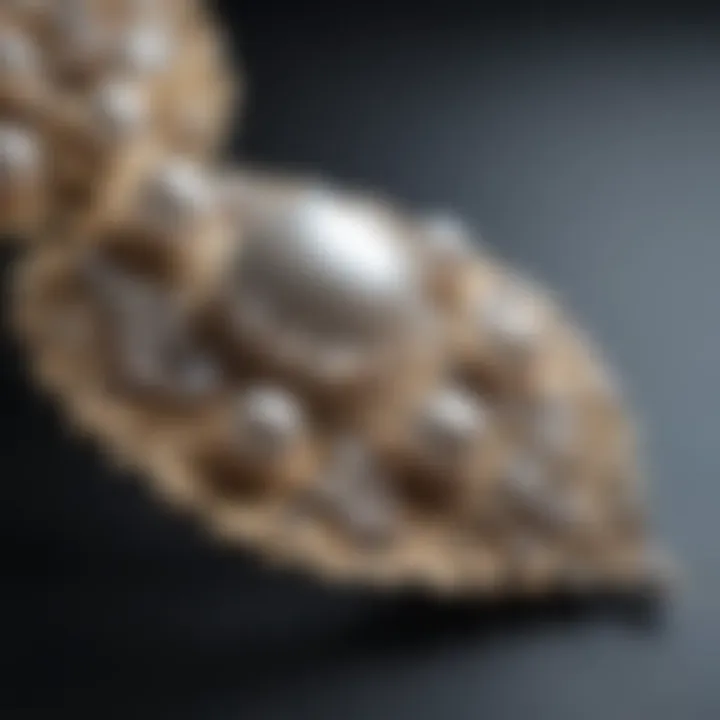
"Sustainable pearl farming is not only beneficial for the environment, but also adds value to the pearls produced, appealing to conscious consumers."
Overall, the careful management of both farming techniques and environmental considerations is fundamental to the success of freshwater pearl cultivation. Promoting sustainable practices not only secures the future of the pearl industry but also ensures that these beautiful gems can continue to be appreciated for generations to come.
Physical Properties of Freshwater Pearls
Understanding the physical properties of freshwater pearls is essential for appreciating their uniqueness and value. These properties influence everything from their aesthetic appeal to how they are perceived in the market. Evaluating these characteristics allows buyers and enthusiasts to make informed decisions, whether for personal enjoyment or investment purposes.
Size and Shape Variability
Freshwater pearls come in a variety of sizes and shapes, which can greatly impact their value and desirability. Typically, these pearls range from 2mm to 15mm in diameter. The larger the pearl, often the more prized it becomes. However, size should not be the only consideration. Shapes such as round, oval, and baroque add further diversity. Round pearls are the most sought-after due to their symmetry and classic appearance, while baroque pearls, with their irregular shapes, offer a unique charm sought by contemporary jewelers.
In terms of evaluation, size should be assessed along with the context of the jewelry design. For instance, smaller pearls might work well in delicate necklaces, while larger ones can dominate a statement piece.
Color Range and Finish
Freshwater pearls exhibit an impressive color range that includes shades of white, pink, lavender, and even golden hues. Each color has its own appeal, often influenced by the specific type of mussel that produced it. Finishes can also vary, impacting how light interacts with the pearl surface. A well-finished pearl will have a smooth surface, contributing to its overall beauty.
Buyers often prefer uniform colors, but variations can enhance the uniqueness of a piece. The best specimens combine rich color with a high-quality finish. This interplay creates a captivating glow that draws attention.
Luster and Surface Quality
Luster refers to the shine of the pearl, which is a critical factor for its visual appeal. High-quality freshwater pearls are known for their intense luster, caused by a smooth, reflective surface that allows light to diffuse beautifully.
Surface quality is another key aspect, as it can affect both appearance and value. Imperfections like bumps, spots, or wrinkles can diminish a pearl's allure. When selecting pearls, inspect the surface closely. A pearl with good luster and minimal imperfections is usually more valuable.
"Luster and surface quality are often the first indicators of a pearl's true value. They should not be overlooked in any evaluation process."
In summary, the physical properties of freshwater pearls are foundational elements influencing their attractiveness and value. By understanding size, color, finish, luster, and surface quality, enthusiasts can appreciate these beautiful gems more fully and make smarter purchasing decisions. This knowledge also enriches the experience of owning and wearing freshwater pearls.
Cultural Significance of Freshwater Pearls
Freshwater pearls hold a distinguished place in various cultures around the globe. Their beauty and rarity have rendered them symbols of wealth, purity, and elegance throughout history. In this section, we will explore the rich cultural tapestry surrounding freshwater pearls, examining their symbolism across different societies and their historical uses in jewelry.
Symbolism in Various Cultures
In many cultures, pearls signify purity and innocence. In ancient China, they were believed to represent the essence of the universe, embodying harmony and enlightenment. The Chinese also associated pearls with wisdom, often gifting them to scholars and notable figures as tokens of respect.
In the Western world, pearls have often been linked to feminine beauty and elegance. In medieval Europe, they became a popular adornment among the nobility, symbolizing not just wealth but also virtue. Similarly, in the Indian culture, pearls are seen as auspicious. They carry a belief of good fortune and are often included in bridal jewelry, signifying the bride's purity and connection to her heritage.
Other societies, such as Arabic cultures, regarded pearls as a sign of royalty and high status. They were frequently worn by kings and queens, often encrusted in crowns or luxurious garments. This reverence for pearls extends into spiritual beliefs, where they are thought to bring clarity and insight.
Historical Uses in Jewelry
Freshwater pearls have played a pivotal role in the evolution of jewelry throughout history. Specifically:
- Ancient Cultures: In ancient Egypt, pearls were so precious that they were buried with royalty, showcasing their worth even in the afterlife.
- Medieval Europe: During the Renaissance, pearl jewelry reached its zenith among the aristocracy. Necklaces, earrings, and elaborate headdresses adorned with pearls were commonplace, serving both decorative and status-signifying functions.
- Modern Era: Today, freshwater pearls are integral to contemporary jewelry designs, merging tradition with modern aesthetics. Designers craft a wide variety of pieces from necklaces to bracelets, keeping the allure of pearls alive.
Historically, the enduring fascination with freshwater pearls can be attributed to their unique physical characteristics, making them versatile and coveted in jewelry making. The interplay between their natural beauty and cultural significance enhances their value, ensuring they remain cherished across generations.
"The allure of pearls transcends time and culture, making them a universal symbol of elegance and sophistication."
Thus, the cultural significance of freshwater pearls is profound and multifaceted, weaving together narratives of beauty, status, and tradition that resonate within societies worldwide.
Market Trends and Economic Aspects
Understanding market trends and economic aspects of freshwater pearls provides insight into their value and relevance. This knowledge is essential for collectors, jewelry designers, and gemstone enthusiasts. Having a grasp on these dynamics influences purchasing decisions and helps in assessing the long-term value of freshwater pearls.
Current Pricing Dynamics
The pricing of freshwater pearls is influenced by various factors. These can include size, shape, color, luster, and surface quality. Supply and demand also play crucial roles. When production increases or there is a surplus, prices may drop. Conversely, if a particular type or quality of pearl is in demand, prices can rise significantly.
Additionally, market trends indicate shifts in consumer preferences. For example, there is a growing appreciation for organic and unique pearls over standard offerings. This change can affect pricing as rare and unique pearls can command higher price points.
- Market research shows that factors like branding and marketing play significant roles in pricing.
- Certain regions known for specific types of pearls may offer distinctive pricing structures.
- It's essential to monitor trends to gauge the timing for purchasing.
Consumer Demand Patterns
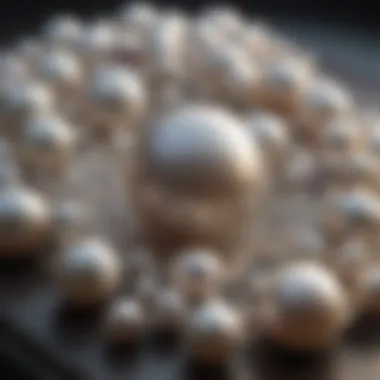
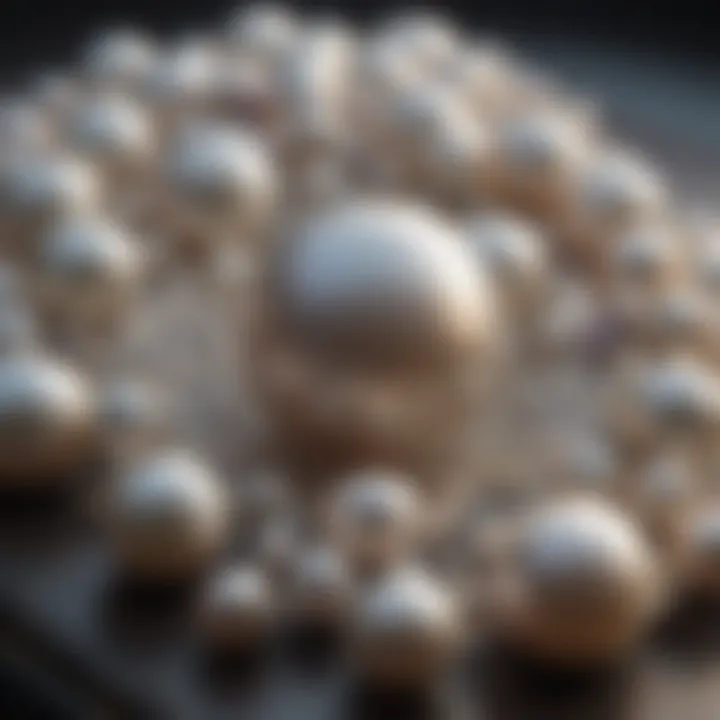
The demand for freshwater pearls has evolved over time. Cultural trends and fashion plays a significant role in driving consumer interest. For example, as sustainable and ethically sourced products gain popularity, pearls cultivated with minimal environmental impact are increasingly sought after.
Market research indicates the following patterns in consumer behavior:
- Customization: Many customers express interest in unique, customized designs, leading designers to explore creative takes on freshwater pearls.
- Education: There is a growing desire among consumers for education about the origins of pearls and their quality indicators.
- Influence of Social Media: Platforms like Instagram and Pinterest have led to a surge in demand for visually appealing pearl jewelry.
"As consumers become more informed, their preferences shift, impacting the dynamics of pearl pricing and collection strategies."
In summary, understanding the current pricing dynamics and consumer demand patterns is imperative for navigating the freshwater pearl market. It empowers buyers to make informed decisions, optimally time their purchases, and appreciate the true value of these exquisite gems.
Practical Considerations for Buyers
As an informed buyer, understanding freshwater pearls offers numerous advantages. This knowledge not only empowers you to make wise purchasing decisions but also enhances your appreciation for these natural gems. The market for freshwater pearls has grown rapidly, with new offerings emerging frequently. Thus, practical considerations become essential for avoiding pitfalls and ensuring satisfaction.
How to Evaluate Freshwater Pearls
Evaluating freshwater pearls requires attention to several key factors. Luster, the way light reflects off the pearl's surface, is paramount. High-quality pearls exhibit a deep, rich luster. Additionally, surface quality matters; look for blemishes or irregularities that can affect the pearl's beauty.
The shape is another indicator of a pearl's quality. Round pearls tend to be more sought after; however, baroque pearls offer unique character. Size is also critical; larger pearls are generally rarer and can command higher prices.
Another important aspect is color. Freshwater pearls come in various hues, ranging from white to deep purples. A more vibrant and unique color can enhance a pearl’s desirability.
Last but not least, consider the pearl’s origin. Knowing if the pearl was cultivated in a reputable farm can assure you of its quality.
"The perfect pearl is an intricate combination of shape, color, luster, and surface quality."
Purchasing Tips
When purchasing freshwater pearls, several tips can help you secure a great deal. First, always buy from reputable dealers or jewelers. Research their background and customer reviews. This can prevent potential disappointments.
Additionally, request certificates of authenticity when buying valuable pieces. A certificate provides assurance of the pearl’s quality and origin.
Prioritize physical examination whenever possible. Inspect pearls under various lighting conditions to evaluate their luster and clarity accurately. Asking if you can see the pearls in natural lighting conditions can be quite informative.
Lastly, be aware of your budget. Freshwater pearls vary widely in price based on their quality and characteristics. Set a realistic budget before beginning your search so that you can focus on pearls within your price range.
By bearing these practical considerations in mind, you can confidently navigate the world of freshwater pearls, ensuring that each purchase is a valuable investment.
Care and Maintenance of Freshwater Pearls
The longevity and beauty of freshwater pearls depend significantly on their care and maintenance. Unlike other gemstones, pearls are organic materials. They require special treatment to preserve their luster and prevent damage over time. It is crucial for jewelry enthusiasts, collectors, and designers to understand the best practices for maintaining these delicate gems. This section will cover essential cleaning procedures and effective storing techniques that enhance the lifespan of freshwater pearls.
Cleaning Procedures
Regular cleaning is vital for maintaining the appeal of freshwater pearls. Their surfaces can accumulate dirt, oils, and other residues, which may diminish their radiant look. When cleaning freshwater pearls, follow these guidelines:
- Gentle Approach: Use a soft, damp cloth to wipe down the pearls after each wear. This will remove any accumulated oils or dust.
- Avoid Harsh Chemicals: Never use cleaning agents that contain alcohol or ammonia. These substances can damage the nacre and lead to permanent discoloration.
- Mild Soap Option: If a more thorough cleaning is necessary, you can use lukewarm water combined with a few drops of mild soap. Dip the cloth in the solution and gently wipe the pearls.
- Drying Precaution: After cleaning, be careful to dry them with a soft, lint-free cloth to avoid any moisture buildup, which can cause deterioration.
"Regularly caring for pearls ensures they maintain their iridescent beauty for years to come."
Following these procedures helps in retaining the unique qualities of freshwater pearls. Taking the time to perform regular cleaning is an investment in their long-term appearance.
Storing Techniques
Proper storage is another crucial aspect in preserving freshwater pearls. When not in use, pearls should be stored carefully to prevent scratches and breakage. Here are some essential tips for storing freshwater pearls:
- Separate Storage: Always store freshwater pearls separately from other jewelry pieces. This avoids scratches and tangles that may occur when pearls are mixed with harder gemstones.
- Soft Cases: Use soft pouches or lined boxes to protect the pearls. Avoid using plastic bags, as they can trap moisture and potentially harm the pearls.
- Avoid Sunlight: Keep pearls away from direct sunlight or high heat sources, as excessive exposure can lead to fading of their color and luster.
- Occasional Check: It is advisable to periodically check the string in pearl necklaces or bracelets. If the string is worn or frayed, consider restrung them to prevent loss.
Culmination
The examination of freshwater pearls in this article highlights their intricate qualities and substantial value in the gemological world. Freshwater pearls, known for their diverse shapes and colors, hold a unique place in jewelry that cannot be understated. They appeal not only for their aesthetic qualities but also for their cultural and historical significance.
The Future of Freshwater Pearls
Looking ahead, the future of freshwater pearls seems promising yet challenging. One significant aspect is the increasing demand for sustainable and ethically sourced materials in the jewelry market. Consumers are becoming more aware of the environmental impact of pearl farming. As a result, the industry may shift towards more eco-friendly practices to satisfy this growing preference. This change could potentially enhance the reputation of freshwater pearls as a responsible choice in fine jewelry.
Additionally, technological advancements in aquaculture may lead to more efficient farming methods. Innovations may improve the health of mollusks and the quality of pearls produced. These developments will likely encourage both new and seasoned pearl farmers to adopt best practices that prioritize sustainability.
Final Thoughts on Value and Preservation
Furthermore, the preservation of traditional crafting methods alongside modern techniques can maintain the cultural significance of freshwater pearls. This balance is essential to keep their charm alive in an evolving marketplace.
Engaging with these aspects can elevate the experience and appreciation of freshwater pearls. As the market continues to evolve, staying informed about these changes will benefit enthusiasts and collectors alike.







